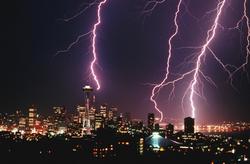Selecting Excited States

Auroras, fluorescent lights, and lightning are all examples of plasmas whose atoms and molecules are excited when energetic particles slam into them. The atoms and molecules emit light when they return to their ground states, but often they hesitate for some time in “metastable” states before relaxing. This process occurs in many phenomena on Earth and in space, but it’s difficult to study in detail in the lab. The 14 June PRL describes a new way to study these metastable states, including specific rotational and vibrational states in molecules–molecular states that are not accessible by other means. The new technique should allow researchers to investigate collision-induced excitation of atoms and molecules in more detail than ever before.
A fast moving electron colliding with an atom or molecule can excite it into a wide range of states that are unavailable with the more commonly practiced laser excitation, which is subject to rigid “selection rules.” Metastable states are excited states that last unusually long–sometimes for hundreds of microseconds–enough time to be picked up by a detector. Andrew Murray and Peter Hammond of the University of Manchester in the UK have come up with a new way to observe collisionally excited metastable states, including molecular states that were previously impossible to resolve: The energy levels associated with rotation and vibration (“ro-vibrational states”) are so closely spaced in energy that researchers usually must observe a whole range of these states simultaneously. The British team’s technique can look at each of them independently.
For their proof-of-principle experiments, Murray and Hammond used helium atoms, which can be excited by electrons into a pair of closely spaced metastable states (though not ro-vibrational ones), and showed that they can distinguish the two. They aimed a beam of nearly uniform velocity helium atoms at right angles with a pulsed electron beam, creating a spray of deflected atoms, some of which were excited into the pair of metastable states. To select one of the two states, they shot a precisely timed 10-ns laser pulse at the deflected atoms. The laser had just the right wavelength to further excite atoms from only one of the states up to a much higher energy “Rydberg” state which was easily detected; the other metastable state was unaffected by the laser. Because the atoms and electrons started with known energies, the researchers could work backwards from the angle and speed of each detected atom to determine its initial and final energy and momentum, as well as those of the electron that excited it.
Hammond says the critical elements of the technique are the laser, which gives “fantastic selectivity on the metastable state,” and the uniform beam of target atoms. Murray adds that after a few small improvements, “We should be able to get all of the information that’s possible” about the collision process. William McConkey of Windsor University in Canada says the new combination of laser techniques with electron scattering experiments could lead to applications in all areas of low temperature plasma physics, from giant interstellar gas clouds to devices like plasma etching machines and new types of lighting.


